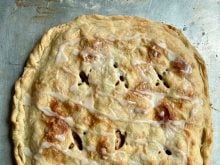Is your skin feeling parched after the winds that winter sent your way? Could your hands double as a scrub brush, due to the scaly skin?
Aside from constantly applying a rich cream and perhaps a facial or manicure, have you ever thought about skin treatment from the inside out?
In an article published by Weight Watchers, Carol Ann Rice writes that a healthy diet has an effect on our outer beauty.
A junk food diet gives a junkie appearance. Making the right food choices can aid the skin in renewal, leading to a glowing appearance. In addition to keeping yourself hydrated by drinking water, here are some foods that were listed:
Read Also

From farmer to award-winning distiller
Pivot Spirits showcases transition from farmer to distiller with provincial award-winning results in Alberta for Lars Hirch
- Strawberries are wrinkle fighters because they contain minerals, vitamins C and B3, silicon and antioxidants that offer protection from sun damage.
- Tomatoes are also wrinkle fighters because they are rich in lycopene, which helps undo environmental damage and purifies the blood.
- Apples and pears help cleanse, relieve eczema and contain enzymes.
- Crunching on a carrot improves the clarity of the skin and clears up spots and blemishes. Rich in vitamins A and B and carotene, carrots can boost the skin’s natural sun protection.
- Lemons are detoxifying aids for the blood and liver. They help prevent broken veins and keep collagen in good condition. Warm lemon juice in hot water each morning helps your body clean from the inside out.
- Sunflower seeds have excellent skin conditioning qualities. Rich in vitamins, protein and minerals, they provide all the skin’s essential nutrients.
- Oats are one of the most nutritious cereals and are packed with energy and nerve-fortifying ingredients. High in calcium, silica, manganese and magnesium, oats can be used as a natural scrub when applied directly to the face or body.
Broccoli quiche
4 large eggs
11/4 cups one percent milk 310 mL
3 slices whole wheat bread,
crust removed, cubed
3 cups broccoli florets, 750 mL
cooked, chopped
1/2 medium onion, chopped
3/4 cup shredded cheddar 175 mL
cheese
Preheat oven to 350 F (180 C). Beat eggs and milk with wire whisk until well blended. Add bread and mix lightly.
Stir remaining ingredients into egg mixture. Pour into nine inch (22 cm) square pan.
Bake 45 minutes or until centre is set and crust is light golden brown.
Let stand 10 minutes before serving. Cut into small squares to serve six.
Silky soup
This spicy soup is perfect for this time of year and tasty with the quiche as an appetizer. It is also great accompanied by a green salad.
2 teaspoons olive oil 10 mL
1 cup carrots, shredded 250 mL
1 medium onion, chopped
1 medium green pepper, chopped 2 cups water 500 mL
1 cup dry lentils 250 mL
1/2 cup uncooked brown rice 125 mL
1/2 teaspoon cayenne pepper 2 mL
1 can (28 oz.) chicken broth 796 mL
1 can (8 oz.) tomato sauce 250 g
1 teaspoon ground cumin 5 mL
1 cup fat-free evaporated milk 250 mL
In oil, sauté carrots, onion and green pepper over medium heat for about five minutes.
Add remaining ingredients, except for milk and stir well. Bring to a boil, cover, reduce
heat and simmer until lentils are tender,
45 minutes.
Put half of lentil mixture in a blender or food processor. Purée until smooth. Pour mixture into a bowl. Repeat with remaining lentil mixture. Return blended lentil mixture to pot and stir in the milk. Cook over low heat for 10 minutes. Yields one cup (250 mL) per serving.
Apple bars
4 apples
1/3 cup granulated sugar 75 mL
2 tablespoons lemon juice 30 mL
1 teaspoon ground cinnamon 5 mL
Crust and crumble:
11/2 cups large-flake rolled oats 375 mL
1 cup all-purpose flour 250 mL
2/3 cup packed brown sugar 150 mL
1/4 teaspoon salt 1 mL
3/4 cup butter, melted 175 mL
Line a nine inch square (2.5 L) metal cake pan with parchment paper, leaving one inch (2.5 cm) overhang for handles. Set aside.
In bowl, whisk together oats, flour, sugar and salt. With fork, stir in butter until mixture is crumbly. Press all but one cup (250 mL) of the mixture into prepared pan. Bake in centre of 350 F (180 C) oven until edges are golden, about 15 minutes. Let cool.
Meanwhile, peel, core and slice apples half inch (one cm) thick. In skillet, bring apples, sugar, lemon juice and cinnamon to boil, adding up to 1/4 cup (60 mL) water if apples stick to pan. Reduce heat and simmer, stirring occasionally, until tender-crisp, about five minutes.
Spread apple mixture over base; sprinkle with remaining oat mixture. Bake in centre of 350 F (180 C) oven until golden, about 30 minutes. Let cool in pan on rack; cut into squares. (Make ahead: Cover and refrigerate for up to three days. Or layer between waxed paper in airtight container and freeze for up
to two weeks.)
Source: Canadian Living test kitchen.
Beauty sleep
Getting enough rest is an important aspect to aging well. Fatigue has been shown to raise levels of cortisol and glucose, causing health problems such as hypertension and Type 2 diabetes, which age people more quickly, according to Dr. James Maas, professor of psychology at Cornell University and author of Power Sleep.
He recommends 7.5 to 8.5 hours a night and suggests that adequate sleep is the best diet there is. Research has shown that compared with people who sleep eight hours a night, those getting five hours have 15 percent lower levels of the appetite-suppressing hormone leptin and 15 percent higher levels of hunger-increasing ghrelin.
“You wake up starving for complex carbohydrates,” Maas said.
Sleep deprivation does more than wreak havoc on the body; its effects also appear on faces.
“Skin cells turn over more quickly when you sleep,” said Jeanine Downie, director of image dermatology in Montclair, New Jersey, and
co-author of Beautiful Skin of Color.
“If you don’t get enough sleep, your skin won’t renew itself and will start looking dull, especially as you age, when cell turnover is slowing down.”
Skin temperature also rises when you sleep, allowing topical treatments to penetrate the skin more effectively than they do during the day. And there’s the badge of fatigue: dark circles. While puffiness is determined by genetics, shadows are often aggravated by lack of sleep, which can cause blood to seep from tiny capillaries beneath the thin skin under eyes.
When I’m done cooking…
At this time of year I tend to go through closets and do some organizing in the house. It all starts when I have to put the Christmas decorations away and everything falls on my head, or the dresser drawers simply will not close. With the work comes cleaning. I have decided that I am going to look for alternative cleaning products instead of breathing fumes of chemicals.
Many common household cleaners contain alcohol, ammonia, bleach, formaldehyde and lye, substances that can cause nausea, vomiting, inflammation and burning of the eyes and throat.
Environmentalists have linked these ingredients with neurological, liver and kidney damage, asthma and cancer.
Here are some of the basic ingredients and combinations you can try.
Basic ingredients:
Any of these ingredients can be safely mixed together. Experiment and find out what works best for you. Store mixtures in spray bottles and label them.
White vinegar: Mix with water and you can clean windows, any glass, countertops and tile.
Baking soda: Mixed with water this becomes an all-purpose cleaner. Scour sinks, tubs and even sprinkle over carpets as a deodorizer.
Salt: Great as an abrasive for cleaning pots and pans.
Lemon juice: Use as bleach in laundry and on kitchen surfaces. Combine with vinegar and water and you have a nice declogger.
Cleaning recipes
Drain cleaner: Pour 1/2 cup (125 mL) of baking soda down the sink and add at least a cup (250 mL) of vinegar. Put the cover on the drain and wait a few minutes. Finish by rinsing through with a mixture of boiling water and salt.
Oven cleaner: Scratch off burned spots with a scouring brush and then apply a paste made of baking soda and water and scrub.
Kitchen cleanser: Use baking soda on non-scratch surfaces and vinegar and water mixture on all others.
Window cleaner: Put 1/3 cup (75 mL) of vinegar for every litre of water in a spray bottle.
Glass cleaner: Blend 1/3 cup (75 mL) of vinegar, a spoonful of cornstarch and a litre of warm water. Apply with a sponge and wipe dry. No streaks.
Crystal: Try a mixture of vinegar, water and a small amount of baking soda. Pour on a soft cloth and rub.
Rust removal: Vinegar can help remove rust on nuts and bolts and other mineral deposits such as calcium.
Toothpaste: Diminishes glass scratches, lifts crayon marks off the floor.
Tub and tile cleaner: Mix 12/3 cups (400 mL) baking soda, 1/2 cup (125 mL) liquid soap, 1/2 cup (125 mL) water and a few spoonfuls of vinegar. Apply, scrub and wipe.
Mildew remover: Vinegar and salt.
Silver polish: Put a sheet of aluminum foil into a plastic or glass bowl. Sprinkle the foil with salt and baking soda and fill bowl with warm water. Soak your silver in the bowl and tarnish migrates to the foil. Dry and buff.
Source: CBC’s The Marketplace newsletter.
Jodie Mirosovsky is a home economist from Rosetown, Sask., and one of four columnists comprising Team Resources. Send correspondence in care of this newspaper, Box 2500, Saskatoon, Sask., S7K 2C4 or contact them at team@producer.com.














